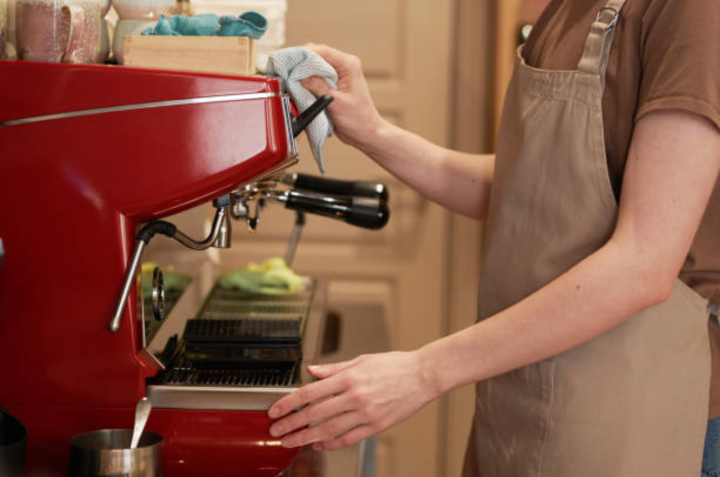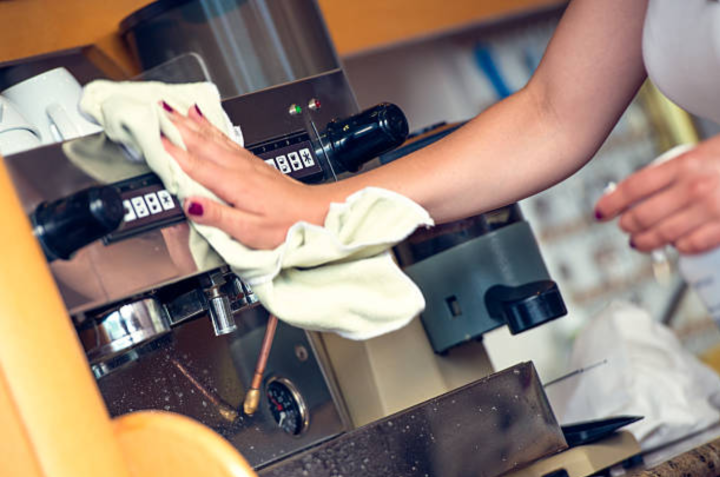
As any coffee lover knows, a dirty coffee maker can ruin your cup of morning joe. But don’t worry – cleaning your coffee maker is actually a quick and easy process! You may have heard of the use of bleach.
But you may not be aware that there are safer and more effective alternatives, such as lemon juice or vinegar mixed with salt. Lemon juice and vinegar have antibacterial and acidic properties and are ideal alternatives to bleach. Read on to learn more!
How do you clean your coffee maker with bleach?
If you’ve been wondering how to clean a coffee maker with bleach, there are a few steps you can follow to ensure the results are as clean as possible. First, you’ll need to fill the pot with water. Use at least five gallons of hot water. Then, use rubber gloves to scrub away any tough stains. When the water has cooled, you can rinse the pot out using plain water.
Baking soda is also an excellent cleaning agent for coffee makers. This natural acid is inexpensive and non-toxic. It is safe for use inside and outside of a coffee maker. Alternatively, you can use a commercially available cleaner, such as Affresh Coffee Maker Cleaner. This is a great option if your coffee maker has been left to sit for a while. It will help remove mineral deposits and hard water residue from the coffee maker’s insides.
You can also use bleach to clean the inside of your coffee maker. Just remember to use the product carefully and never inhale the vapors. Bleach can be harmful to your eyes and nose.
Safety tips to clean Coffee maker with bleach
Bleach can be dangerous to your coffee maker, but there are many ways to clean it safely. You can use mild bleach, such as Clorox, to clean it. To do this, simply mix one teaspoon of bleach into one gallon of warm water. Run the coffee maker through this solution, making sure to use a rinse cycle to rinse it thoroughly. You can also use other cleaning solutions such as lemon juice, vinegar, or baking soda. These solutions are all-natural and safe, but they might not be as effective as bleach.
Once you’ve used bleach to clean your coffee maker, run it through it again, using a fresh gallon of water. This will minimize the amount of time you spend heating water for your coffee maker. It may take several runs, depending on the type of coffee maker you have. You don’t want to leave it running for hours at a time or risk being sick from the bleach.
Alternatives methods for cleaning coffee maker
Before you use bleach to clean a coffee maker, consider a few alternatives. For one thing, bleach can be hazardous if it gets into your eyes. The fumes it gives off are toxic and can damage your eyes permanently. Not only that, but you also risk exposure to the dangerous chemicals found in bleach.
If you’re looking for a non-toxic alternative to bleach for cleaning your coffee maker, try lemon juice or white vinegar. Although these methods are less effective than bleach, they both have antimicrobial properties and remove calcium deposits in the coffee maker. Both vinegar and lemon juice will also make your coffee maker smell better.
Using bleach to clean a coffee maker is dangerous because it can irritate your throat and may not dry the coffee maker completely. Additionally, bleach is toxic and should not be ingested, so be careful when you use it. It’s best to avoid bleach altogether and look for an alternative.
Cleaning a c0ffee maker with baking soda
Baking soda is an effective cleaning ingredient that can remove dirt and gunk in your coffee maker. Mix it with some hot water and pour it into the sink to clean the coffee maker. After letting it sit for a few minutes, rinse the coffee maker thoroughly with warm water and soap.
Baking soda is also a good alternative to vinegar. It is very cheap and effective for cleaning coffee makers. Mix a quarter cup of baking soda with a cup of warm water. Pour the mixture into the coffee maker’s water reservoir, and let it sit for 30 minutes to an hour. Rinse thoroughly with clean water. Repeat this process if necessary. The coffee maker should then be ready for use.
In addition to cleaning your coffee maker, you can use baking soda to clean other appliances in your kitchen. The two ingredients work well together, creating a fizzying reaction that makes them the ideal cleaner. You can also use these two ingredients to clean taps and watermarks.
Can you clean the coffee maker with Vinegar?
Vinegar is a natural cleaner and descaler that can be used to clean your coffee maker. However, you should follow the manufacturers’ instructions to clean your coffee maker. The first step is to pour some vinegar into the water reservoir of your coffee maker. Pour in enough water to cover the filter, and allow it to sit for 30-60 minutes.
The second step is to rinse out your coffee maker. This will remove any mineral buildup and clean the machine. This process is called descaler and should be done at least once a month. You can use the vinegar and water solution for this, but you may want to use a different cleaning solution.
The vinegar solution is a simple solution to clean coffee makers. Simply mix equal parts water and distilled white vinegar and pour the solution into the water reservoir. After this, you can run a cycle to clean your coffee maker. You can repeat this step twice, depending on how much buildup you have.
Coffee maker cleaner available on Market
Bleach is a chemical that can damage your skin, eyes, and lungs. So, if you’re thinking about cleaning your coffee maker with bleach, here are a few things you should do first. When cleaning coffee makers, use hot water. It will be easier to rinse the coffee maker with this solution.
Vinegar is a great alternative to bleach. Not only is it cost-effective and convenient, but it can also remove stubborn buildup from coffee makers. The main disadvantage of vinegar is that it can leave a smell, but you can handle this problem by running the machine through its full cycle with a mixture of vinegar and water. After that, use a plain water cycle to rinse the machine of vinegar residue. The vinegar will leave the coffee maker smelling slightly sour. To minimize the smell, you can use either apple cider vinegar or baking soda.
Bleach can be a dangerous chemical, and you should always dilute it before using it. It can irritate your throat and mouth and can even damage your coffee maker. For this reason, it is very important to dilute bleach thoroughly with water before using it.
Diluted bleach Method
If you want to clean your coffee maker without damaging it, you can use diluted bleach. This solution can remove stubborn buildup and stains. However, you should be careful because bleach has some risks. Use it only when necessary and with the appropriate frequency. Then, rinse it with warm water.
You should also remember that bleach is one of the most toxic chemicals. Therefore, it is best to use only diluted bleach to clean your coffee maker. If not diluted, it can corrode parts of your coffee maker and leave a residue that you can’t completely get rid of. Also, the bleach residue will leave your coffee maker with an odd smell and taste.
If you’re using bleach on your coffee maker, you should dilute it with water. It can also cause burns if you get it on your skin. Make sure to use protective gloves while doing the job, since the fumes from bleach can damage your eyes and skin.
Additional Tips for Cleaning Coffee Makers
Bleach is an excellent cleaning agent, but it should be used carefully. It can be harmful to your coffee maker, especially when used improperly. Bleach is highly caustic and incredibly toxic. You should wear protective gear when using it, and rinse your hands thoroughly afterward.
If the bleach dries to solid white specs, flush the system with clean water. If this method fails, use a nontoxic alternative for disinfecting the coffee maker’s insides. Before you begin cleaning with bleach, remove the filter. Also, make sure to dry the reservoir in between brews.
Another option for cleaning coffee makers is to use lemon juice or white vinegar. Lemon juice and vinegar contain citric acid, which is effective against bacteria and mold. They will also help remove calcium deposits and make your coffee maker look and smell better.







